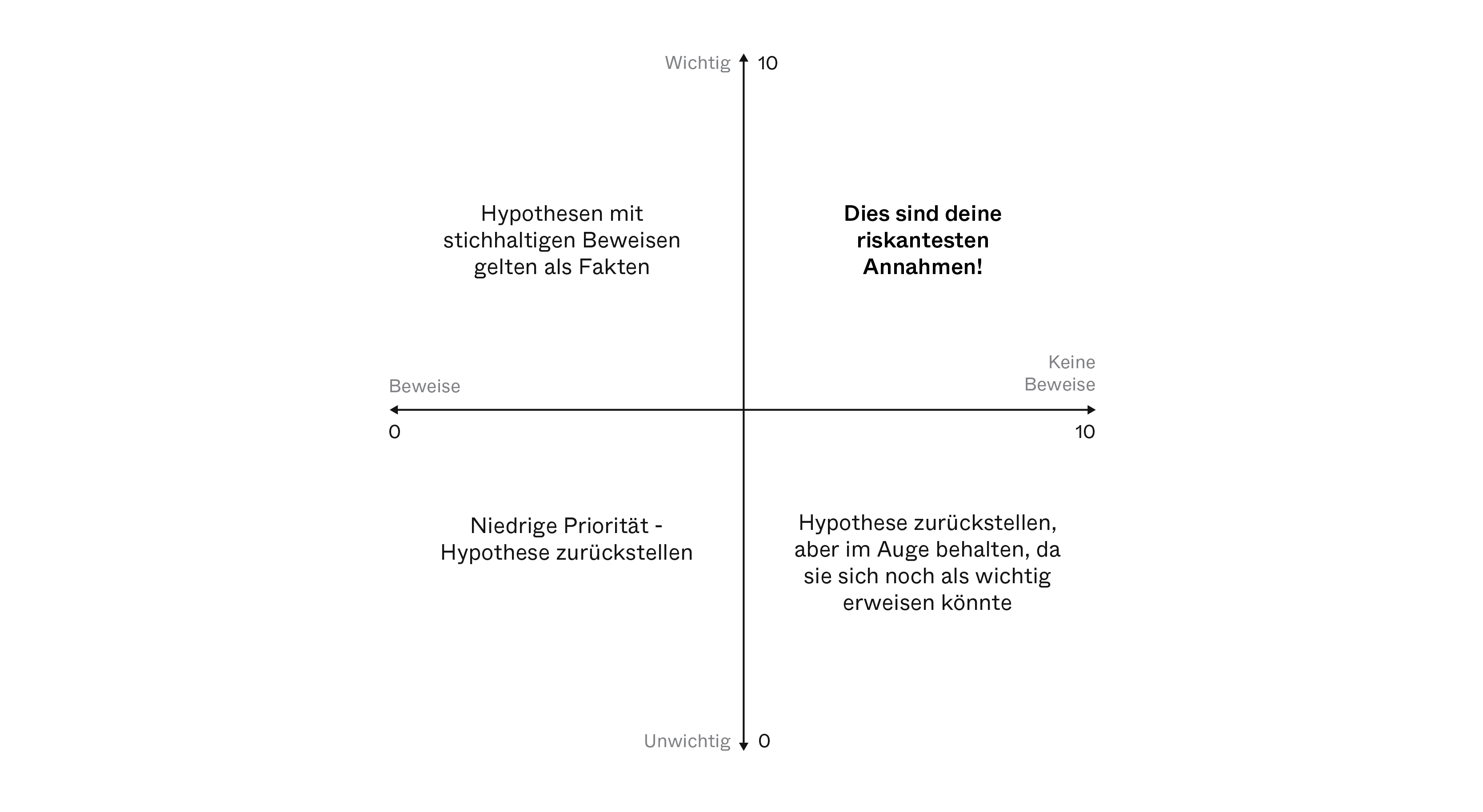In today's data-driven world, it makes sense for every important business decision to be based on a thorough analysis. In the development of new business, hypothesis testing plays a crucial role in making well-founded statements about new business ideas, market changes, willingness to pay and the potential of new technologies. In this article, we will take an in-depth look at hypothesis testing in innovation and explore the importance of this statistical method for data-based decisions in the business world.
Hypothesis testing in innovation: the science behind data-driven decisions
Why are hypothesis tests important?
Hypothesis testing is critical to making informed business decisions. By creating and testing hypotheses, we can ensure that our strategies and future business ideas are based on solid data and evidence. This minimizes the risk of bad investments and allows us to allocate our resources more efficiently.
Basics
In general, hypothesis testing is a statistical procedure that enables experts to draw conclusions from data and test assumptions about certain relationships. It consists of two main components: the null hypothesis (H 0) and the alternative hypothesis (H 1). The null hypothesis represents the current hypothesis to be tested, while the alternative hypothesis represents an alternative assertion to be proven. The entire process is based on probability theory and provides information on whether the available data provides sufficient evidence to reject the null hypothesis in favor of the alternative hypothesis.
An important part of the hypothesis test is the acceptance and rejection range. The acceptance range contains the values for which the null hypothesis is valid and is not rejected. The rejection range contains the values for which the null hypothesis is rejected. The decision as to whether the null hypothesis is accepted or rejected depends on a predetermined significance level. A significance level of 0.05 or 5 % is often used, i.e. there is a 5 % probability that the null hypothesis will be falsely rejected. Careful interpretation of the test results and the choice of an appropriate significance level are important in order to be able to draw well-founded conclusions.

Steps and procedure of hypothesis tests
A hypothesis test for innovation projects is carried out in several steps to ensure a clear and structured analysis. The most important steps are
- Step: Formulate hypotheses
- Step: Prioritize risks
- Step:Selecting the appropriate test or experiment
- Step: Determination of the significance level
- Step: Data collection and analysis
- Step: Interpretation of the results
Step 1: Formulate hypotheses
First, the null hypothesis and the alternative hypothesis are formulated clearly and precisely.
Good hypotheses...
- Describe a fact that we assume to be true
- Can be tested through experiments
- Can be verified or falsified
- Are clear, consistent and measurable
Step 2: Prioritize risks
Which of the hypotheses put forward has the greatest influence on the success or failure of your idea?
The prioritization is clear thanks to the classification in the risk matrix. We work with an adaptation of classic risk management. Instead of including a probability of occurrence, we take into account how substantiated the hypotheses are. In this way, we determine where the greatest uncertainties lie and can focus on them.

Step 3: Selecting the appropriate experiment
The appropriate hypothesis test is selected depending on the type of data and the research question. When making the selection, it is crucial to define in advance what result is expected in order to evaluate the test or experiment as a successful validation of the hypothesis. If no success criteria can be formulated, the hypothesis or experiment should be revised again.
Examples of experiments:
Qualitative experiments: Qualitative experiments aim to establish or substantiate hypotheses.
- Interviews
- Demo Pitch
- Chatbot (open questions)
Quantitative experiments: Quantitative experiments aim to clearly verify or falsify hypotheses.
- Landing page test
- Wizard of Oz
- Ad Trigger Tests
Step 4: Determination of the significance level
As mentioned above, a significance level of 0.05 or 5 % is often used, i.e. there is a 5 % probability that the null hypothesis will be falsely rejected.
Step 5: Data collection and analysis
The data is then statistically analyzed to calculate the test value. This indicates how strongly the available data speaks against the null hypothesis. On the basis of a previously defined significance level, a decision is made as to whether the null hypothesis is rejected or upheld. A low significance level indicates that the data are strong enough to reject the null hypothesis and accept the alternative hypothesis. In contrast, a high significance level indicates that the data is insufficient to reject the null hypothesis.
Examples of qualitative measurement criteria:
- Derivation of clear patterns within clear target groups/personas
- Recurring information within clear target groups/personas
Examples of quantitative measurement criteria:
- Conversion rate
- Cost per conversion
- Number of signed letters of intent
Step 6: Interpretation of the results
If our experiments are positive and the hypotheses are verified, we can simply start with the next step, MVP development.
What is crucial, however, is what we do when our experiments turn out to be negative. This results in two necessary actions:
- Deriving the impact: What does it mean for the business case if a hypothesis is falsified? Does the market size decrease? Is the willingness to pay lower than expected? Do we have higher customer acquisition costs as a result?
- Pivot: Can or must we tweak the product or business model in order to be successful? This results in further hypotheses that should be tested again.

Possible challenges and sources of error
Although hypothesis testing is a valuable method for analyzing data, there are also some challenges and errors that should be considered. A common problem is choosing the right test for the given question and type of data. The wrong test can lead to inaccurate or misleading results. In addition, it is important to set the significance level appropriately to minimize the risk of wrong decisions. Too high or too low significance can lead to incorrect conclusions. Data quality should also be carefully checked to ensure that the results are reliable. An inadequate database can impair the validity of a hypothesis test.
Tips for successfully testing hypotheses
In order to carry out hypothesis tests successfully and obtain meaningful results, it is important to follow a few best practices.
- Formulate hypotheses clearly: Make sure that the null and alternative hypotheses are formulated clearly and precisely. Unclear or vague formulations can lead to confusion and impair the validity of the test.
- Select the appropriate test: Select the appropriate hypothesis test based on the research question and the type of data. Careful selection ensures that the test provides the necessary information to test the hypotheses.
- Sufficient data basis: Ensure that sufficient data is available to obtain meaningful results. A sample that is too small can reduce the statistical significance of the test and impair the validity of the results.
- Determining the significance level: Choose an appropriate significance level to minimize the risk of wrong decisions.
- Interpretation of the results: Take time to carefully interpret the results of the hypothesis test. Don't just rely on the p-values, but also look at the effect size index to assess the practical relevance of the results.
- Ensure reproducibility: Document the entire process of hypothesis testing, including data collection, analysis methods and results. Transparent documentation ensures the reproducibility of the test and enables others to check the results.
- Combine hypothesis tests: In more complex studies, it can be useful to combine multiple hypothesis tests to gain more comprehensive insights. Combining different tests can provide a more comprehensive picture and lead to more informed decisions.
Case study: Hypothesis test for email campaigns
To illustrate the practical application of hypothesis testing in new business validation, let's look at an example of an email campaign designed to test 2 value propositions. The team has designed two emails per value proposition and wants to find out which one achieves a higher open rate. The hypothesis test is used to answer this question.
Hypotheses:
- Null hypothesis(H0): There is no significant difference in the open rate between the two emails.
- Alternative hypothesis (H1): There is a significant difference in the open rate between the two emails.
Collection of data:
The team selects a random sample of 1000 email subscribers. Half of the subscribers receive the first email (group A), and the other half receive the second email (group B). The open rate is measured as the number of emails opened in each group.
Hypothesis test:
The team collects the data after a predetermined period of time and carries out the hypothesis test. They use a two-sample t-test to compare the mean values of the opening rate of the two groups.
Results:
After the hypothesis test was performed, the results are as follows: The average open rate in group A is 20%, while the average open rate in group B is 25%.
Interpretation
The statistical analysis shows that the p-value of the test is below the specified significance level of 0.05. This means that there is a significant indication of a difference in the open rate between the two emails. The null hypothesis can therefore be rejected.
Conclusion
Based on the results of the hypothesis test, the team found that the second email achieved a significantly higher open rate than the first email. This shows them that the second value proposition generates considerably more interest in the test group than the first. This gives the team an initial indication of how the market would react to the value proposition. The data-based decision leads to a better understanding of the target group, increased chances of success when entering the market and a reduction in risk.
The use of hypothesis testing has proven to be an indispensable method for making data-driven decisions and increasing the success of innovation initiatives. By understanding the basics, different types of hypothesis testing and best practices, you can improve your research and analysis and develop successful strategies based on solid data. The systematic application of hypothesis testing enables organizations to efficiently deploy their resources and strengthen their competitiveness in an increasingly data-driven business world.
FAQ
What is the purpose of hypothesis testing in innovation?
The purpose of a hypothesis test is to make well-founded decisions about new ideas, concepts or innovations. This reduces uncertainties and increases the success of innovation projects.
What are the advantages and disadvantages of hypothesis tests?
Hypothesis tests offer objectivity and the ability to quantify uncertainty, but can also be misinterpreted and disregard certain variables.



